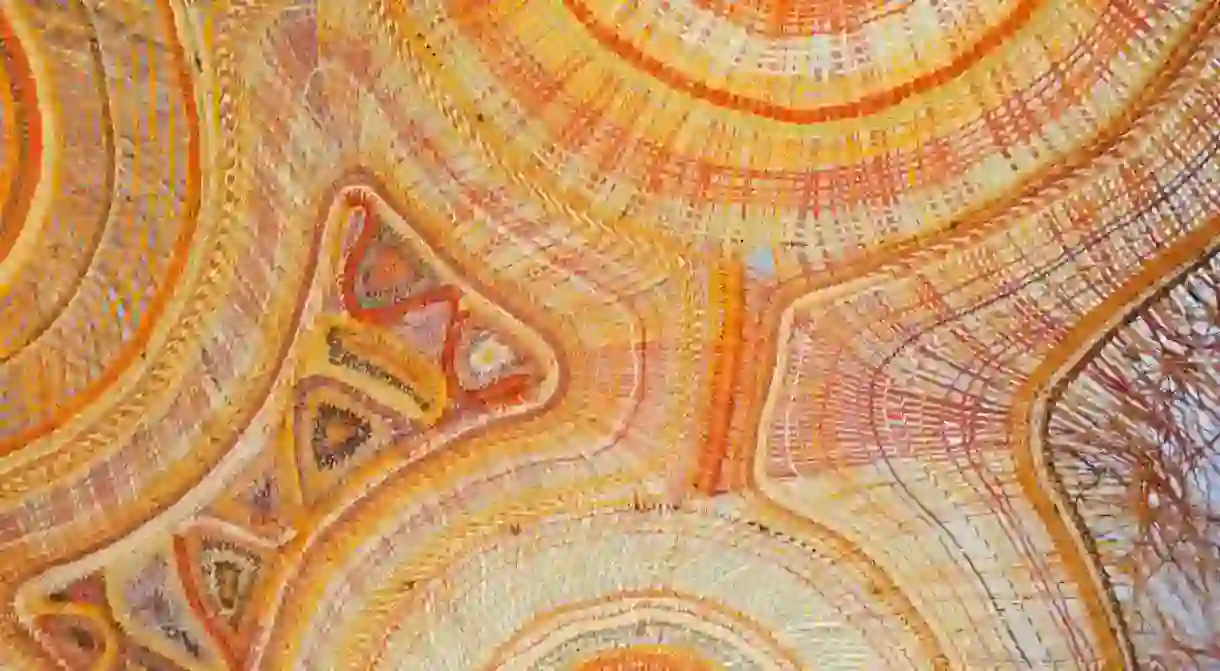PET Lamp: The Bright Idea Weaving Plastic Waste and Aboriginal Textiles Together

Spanish designer Alvaro Catalán de Ocon’s latest PET Lamp project, which was showcased at Rossana Orlandi’s showroom during Milan Design Week 2018, is a hyper-local, creative response to a giant universal problem – plastic waste.
Catalán de Ocon worked collaboratively with eight indigenous weavers in Arnhem Land, part of Australia’s northern territory, to transform ocean-bound plastic bottles into a creative work of art that also utilises and promotes the traditional textile techniques of local weavers.

‘We wanted to use local resources and craftsmanship rather than industrial processes, and to reuse instead of simply recycle,’ explains Catalán de Ocon. ‘We cut the plastic bottle into strips so it becomes like a loom you can weave on, combining a global object with the local weaving technique of basket making.’
The six-week project was commissioned by the National Gallery of Victoria, who put Catalán de Ocon in touch with the remote community of Ramingining. The local artisans are mostly known for creating traditional mats out of a fibre called pandanus, which is taken from palm trees and dyed with natural pigments.

Their customary weaving technique and the community’s cultural influences have been brought together to create a structure that represents both the topography of the Australian landscape and the complex family bonds between the Aboriginal weavers.
‘There are two ways of living in the country that are very distinct,’ says Catalán de Ocon. He began his research by studying a night satellite view of the country, which inevitably showed up concentrations of inhabited areas in the Western coastal cities, but to his surprise it also revealed remote inland areas lit up by the controlled forest fires made by indigenous Australians.

This discovery inspired the basic shape of the overall lamp, with the PET plastic bottles representing the Western urban cores and the weaving referencing the Aboriginal fringe communities.
However, once Catalán de Ocon began working with the weavers, this map-like characteristic of the PET Lamp took on another dimension, with the Bukmukgu Guyananhawuy (meaning ‘every family thinking forward’) essentially becoming a family tree that links each of the artisans together.

Interestingly, one of the weavers called Mary is the twin sister of famous aboriginal actor David Gulpilil, who featured in Walkabout and Baz Luhrmann’s Australia. Each of the eight weavers were commissioned to create one lamp each, but Mary created two, explaining she had a dual vision of the world and all her creations have a twin piece.
This inspired the idea of connecting the fibres, much like an umbilical cord, to merge the individual pieces together, illustrating the strong nature of Aboriginal kinship.

‘We began to understand all the different family bonds, which are far more complex than you might think, explains Catalán de Ocon. ‘They have a blood bond, which we are familiar with in Western culture, but they also have one of the skin that is linked to their territory, plus distinct dialects, so when you end up in an area where you no longer understand someone, it means you should return to your boundary. Then there’s also the totem, which are animals they assign to each other.’

Catalán de Ocon admits this type of project has its cultural implications, especially when it comes to the project’s longevity and profitability. ‘While this project could be a commercial success I feel everything is so linked to money – it’s not as simple as that. I would rather invest in a space for the community to continue weaving and keep it sustainable rather than just pay them cash.
‘There’s a concept called “handbagging”, which links back to when they were nomads and had no property, so if an aboriginal person comes up you and asks you for something you have to give it to them. If they asked for water, a place to stay or something to eat, you would honour that request, and that still remains deeply rooted in their culture. If we paid them $10,000 and someone passed them by and asked for money, they would have to give it to them, simple as that.’


This isn’t the first time Catalán de Ocon has worked with artisans to create lamps out of the waste material. The idea was conceived back in 2011, way before the ‘war on plastic’ became a hot topic. Catalán de Ocon created the first PET Lamp collection in Colombia, which went on to win awards, including London Design Museum’s ‘Design of the Year’.
For more information on the project and to read about Catalán de Ocon’s journey, click here.













